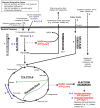Bacterial Metabolism Shapes the Host-Pathogen Interface
- PMID: 27337445
- PMCID: PMC4922512
- DOI: 10.1128/microbiolspec.VMBF-0027-2015
Bacterial Metabolism Shapes the Host-Pathogen Interface
Abstract
Bacterial pathogens have evolved to exploit humans as a rich source of nutrients to support survival and replication. The pathways of bacterial metabolism that permit successful colonization are surprisingly varied and highlight remarkable metabolic flexibility. The constraints and immune pressures of distinct niches within the human body set the stage for understanding the mechanisms by which bacteria acquire critical nutrients. In this article we discuss how different bacterial pathogens carry out carbon and energy metabolism in the host and how they obtain or use key nutrients for replication and immune evasion.
Figures


Similar articles
-
Metabolic Adaptations of Intracellullar Bacterial Pathogens and their Mammalian Host Cells during Infection ("Pathometabolism").Microbiol Spectr. 2015 Jun;3(3). doi: 10.1128/microbiolspec.MBP-0002-2014. Microbiol Spectr. 2015. PMID: 26185075
-
Microbial quest for food in vivo: 'nutritional virulence' as an emerging paradigm.Cell Microbiol. 2013 Jun;15(6):882-90. doi: 10.1111/cmi.12138. Epub 2013 Apr 3. Cell Microbiol. 2013. PMID: 23490329 Review.
-
Breathing life into pathogens: the influence of oxygen on bacterial virulence and host responses in the gastrointestinal tract.Cell Microbiol. 2011 Feb;13(2):171-6. doi: 10.1111/j.1462-5822.2010.01549.x. Epub 2010 Dec 19. Cell Microbiol. 2011. PMID: 21166974 Review.
-
Metabolic host responses to infection by intracellular bacterial pathogens.Front Cell Infect Microbiol. 2013 Jul 9;3:24. doi: 10.3389/fcimb.2013.00024. eCollection 2013. Front Cell Infect Microbiol. 2013. PMID: 23847769 Free PMC article. Review.
-
Revisiting the host as a growth medium.Nat Rev Microbiol. 2008 Sep;6(9):657-66. doi: 10.1038/nrmicro1955. Nat Rev Microbiol. 2008. PMID: 18679171 Free PMC article. Review.
Cited by
-
Adaptive physiological and metabolic alterations in Staphylococcus aureus evolution under vancomycin exposure.World J Microbiol Biotechnol. 2024 Sep 16;40(10):322. doi: 10.1007/s11274-024-04128-2. World J Microbiol Biotechnol. 2024. PMID: 39283509
-
Persistence of Burkholderia thailandensis E264 in lung tissue after a single binge alcohol episode.PLoS One. 2019 Dec 10;14(12):e0218147. doi: 10.1371/journal.pone.0218147. eCollection 2019. PLoS One. 2019. PMID: 31821337 Free PMC article.
-
The ArcAB Two-Component System: Function in Metabolism, Redox Control, and Infection.Microbiol Mol Biol Rev. 2022 Jun 15;86(2):e0011021. doi: 10.1128/mmbr.00110-21. Epub 2022 Apr 20. Microbiol Mol Biol Rev. 2022. PMID: 35442087 Free PMC article. Review.
-
Extracellular adenosine modulates host-pathogen interactions through regulation of systemic metabolism during immune response in Drosophila.PLoS Pathog. 2018 Apr 27;14(4):e1007022. doi: 10.1371/journal.ppat.1007022. eCollection 2018 Apr. PLoS Pathog. 2018. PMID: 29702691 Free PMC article.
-
Co-occurrence of ST412 Klebsiella pneumoniae isolates with hypermucoviscous and non-mucoviscous phenotypes in a short-term hospitalized patient.mSystems. 2024 Jul 23;9(7):e0026224. doi: 10.1128/msystems.00262-24. Epub 2024 Jun 21. mSystems. 2024. PMID: 38904378 Free PMC article.
References
-
- Lipmann F. Metabolic generation and utilization of phosphate bond energy. Adv Enzymol Rel S Bi. 1941;1:99–162.
-
- de Duve C. The other revolution in the life sciences. Science. 2013;339:1148. - PubMed
-
- Adler CJ, Dobney K, Weyrich LS, Kaidonis J, Walker AW, Haak W, Bradshaw CJ, Townsend G, Soltysiak A, Alt KW, Parkhill J, Cooper A. Sequencing ancient calcified dental plaque shows changes in oral microbiota with dietary shifts of the Neolithic and Industrial revolutions. Nat Genet. 2013;45:450–455, 455e451. - PMC - PubMed
Publication types
MeSH terms
Substances
Grants and funding
LinkOut - more resources
Full Text Sources
Other Literature Sources

